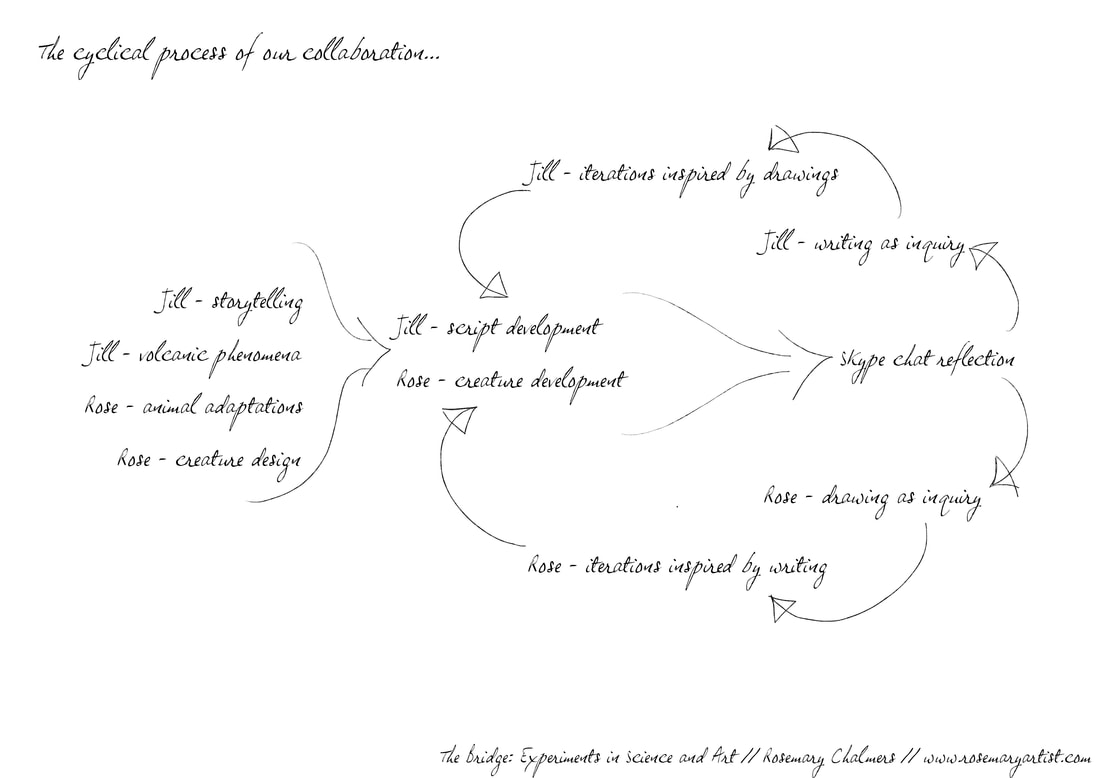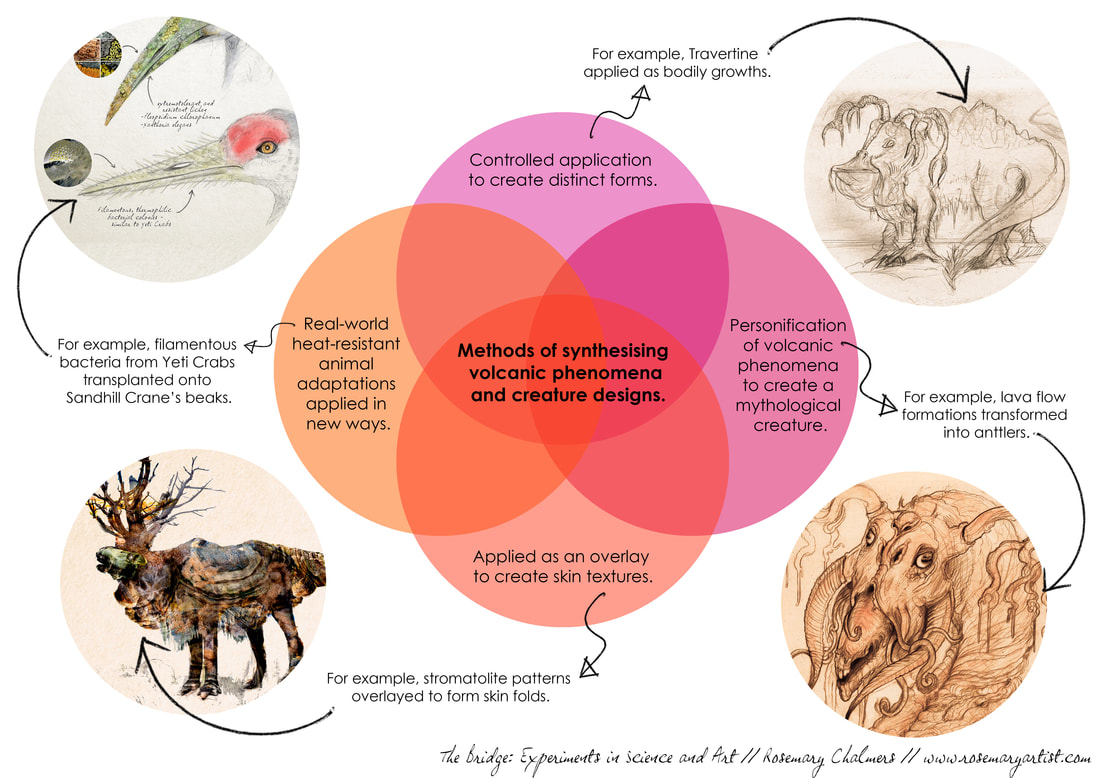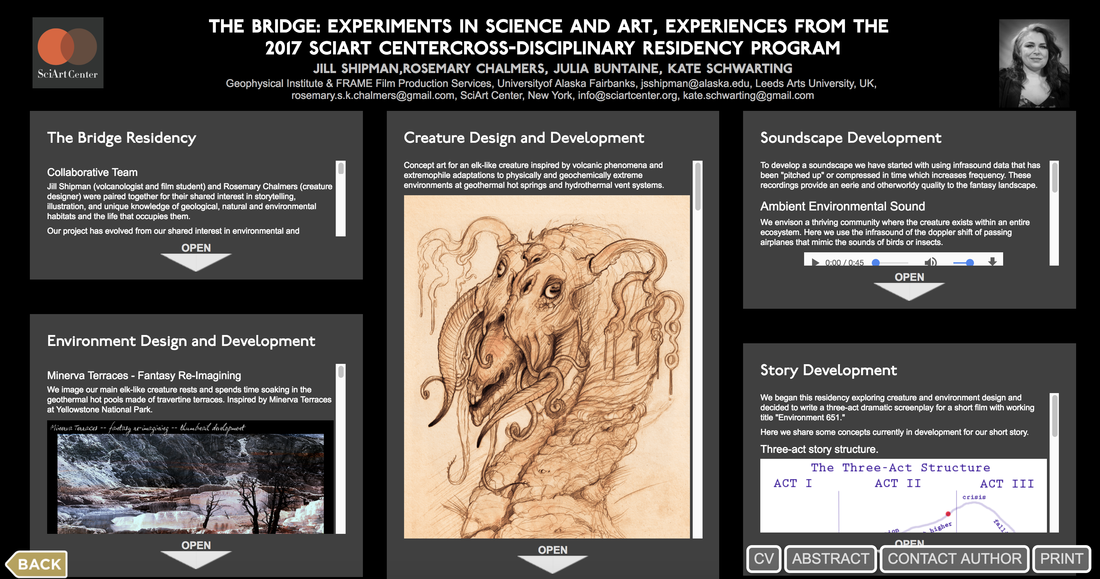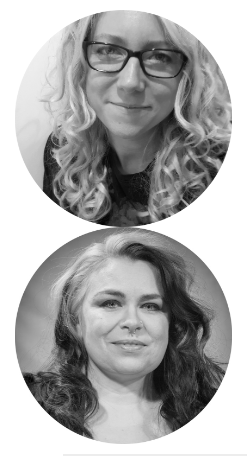|
Rosemary My preconception of working across disciplines on entering the residency was that Science would help legitimise my Art. For example, the creatures that I design would be more believable if they were based on principles of Science. The residency has enlightened me to the fact that this is just one method of Science and Art collaboration. The route we took was more of an explorative approach. The creatures were less speculative biology and more speculative fiction. We let the narrative play an important role in the development of our project. Jill’s specialism of Volcanology was a starting point and the ‘what if’ creatures explored the possibilities of where Science can take the imagination. The most valuable aspect of the residency was the fact that there was not a required output. The fact that we could let the project develop organically and not be focused on producing a final product was beneficial because it allowed us to take our time and really discover what it was Jill and I wanted to communicate. With the luxury of time, this meant that Jill and I developed a process that was cyclical. I have illustrated this feedback loop below. This allowed for us to build on each other’s’ work in an iterative way producing work that was very novel to me. Drawing as inquiry Through testing ways to synthesize volcanic phenomena and creatures, I have discovered more about my practice. There are four methods that I used to incorporate volcanic features into the creatures I designed:
To further illustrate the impact the residency has had on my drawing practice, I have visualized the discoveries I made below. Plans for the future The residency has been an amazing experience. Collaborating with Jill has been rewarding and inspiring. We are most definitely going to continue the project we have been developing. We have been discussing the next steps for our collaboration: as well as further world-building and script development we will be inviting more third-party evaluation and looking for venues and funding to put on a trans-media exhibition or interactive workshop. Acknowledgments Thank you so much to Julia and Kate for all their hard work, guidance and patience throughout the residency. I am grateful for this fantastic opportunity and I hope to have the chance to work together again. It goes without saying that I am over the moon that I was paired with Jill. Thank you for being such an inspiration and a pleasure to work with. I’m looking forward to going forward and really making something of this project we have created! As this is the last blog post of the residency, thank you for your interest, cheerio and take care! Rose http://www.rosemaryartist.com/ Jill Reflections on the Collaborative Residency Prior to this residency, I had participated in collaborative art and science projects before but the focus was on creating an end product. For example, a film or sculpture, and based around a set theme, Arctic Science. While this is a great way to collaborate, participating in the Bridge Residency has made me realize there are different approaches to collaboration. Through the Bridge Residency, we focused more on process and had ample time to create a foundational dialogue that enabled us to explore different ideas and synthesize our expertise and interests in a way that I couldn’t have foreseen at the beginning of the residency. Our project evolved iteratively and organically, developing story and creature design by exploring properties of volcanic phenomena. We concentrated more on what created a good dialogue and exploration of ideas rather than the product. However, we did have the constraint of a presentation at a national conference, American Geophysical Union Fall Meeting. This helped us to highlight the value of our collaborative work-in- progress and to engage in stimulating discussions with colleagues at the conference. I found this freedom to explore ideas through process to be the most valuable aspect of the
residency. My definition of what is a collaboration and what is SciArt have both broaden significantly. I feel like a successful collaboration comes from sharing ideas and through listening and understanding the process of each approach, both scientific and artistic. Skype Meetings - Idea Exploration and Collaborative Work Sessions Rose and I met weekly, if not twice weekly throughout the residency on Skype. I really enjoyed these calls, every time we met, we explored scientific concepts, creature design, writing, storytelling and more. We had time to discuss our interests, ask each other questions, and had time to learn from one another. If anything, our biggest challenge was focusing our what-ifs because we were both invigorated by our weekly “knowledge expeditions.” Since my scientific background is in volcanology, we discussed volcanic phenomena including different types of volcanic eruptions and their deposits, volcanic flows and their emplacement mechanisms and how these are expressed in a range of textural formations. Chemical and thermal dependence, plate tectonics, rock and mineral compositions, distribution and cooling rates, bacteria, archaea and algal mat communities, geologic history and the fossil record. We explored current theories of how life originated on earth in hot springs and hydrothermal vents evidenced in the geologic record as well as theories about how these extremophile organisms may exist on other planets. While I was able to share expertise in volcanology and writing. I learned so much from Rose about creature design, speculative biology, adaptations and artist workflow. Additionally, these meetings prompted me to engage in discussions with colleagues in other disciplines at my University such as microbiologists and veterinary scientists to discuss the design elements that Rose and I were developing. Previously my work has centered on volcanic hazards and their impacts to nearby communities and to air traffic. It was a broadening experience to think about volcanic ecosystem, the interplay between the animals and the habitats in volcanically active regions. Through this exploration, I learned more about how organisms adapt to these conditions and the diversity of life that can be found at extremes of temperature, pressure, and chemical compositions. Skype Meetings with SciArt Center The bi-weekly Skype calls with SciArt Center were crucial to the success of the residency. It was extremely helpful to have Julia Buntaine and Kate Schwarting as sounding boards and to get their input on our project. After every meeting, I felt like we had a more crystallized vision of the project evolution and always felt inspired for the next week. Weekly Blog This was my first experience in writing a regular blog and maintaining an online presence. I found this part extremely challenging at times. It was a new thing for me to share process work, and in-progress thoughts and ideas. Sharing this residency journey through writing was an integral part of the residency documentation and it was extremely helpful to reflect on each week’s work, refining the direction for the following week. I also now have the courage to carry on blogging in the future however someone else may have to set those deadlines for me! For the Future I greatly appreciate the opportunity to participate in this residency. Special thank you to Julia and Kate for their mentorship through this process and to Rosemary Chalmers for being a fantastic collaborator. I highly recommend this collaborative residency, I have been spreading the word to colleagues in Fairbanks and at the AGU Fall Meeting, promoting the program during our presentation and through networking discussions. The innovative approach to the SciArt Center residency was extremely beneficial, providing me with a more holistic way to view my work. I have forged new relationships and strengthened communication with others interested in working on interdisciplinary projects at the intersection of the arts and sciences. I had an incredible time working with Rose and am very grateful to have been paired with her during this residency. I learned so much and had such a fun time throughout the process. Rose and I plan to continue working on the project and to develop our concept further. My next course of action is to finalize the story of “Environment 651,” as deadlines loomed for the AGU conference I had to shift priority to creating the presentation. In addition to our film pitch idea, we are currently exploring locations that could facilitate a future reading and gallery exhibition. Inspired by discussions at AGU, we may develop a creature design workshop and will work more in developing soundscapes using infrasound data. We will continue to flesh out these ideas and hopefully will have the opportunity to meet in person in the near future. Thank you to those who followed our blog during the residency. I hope you found it helpful to come along on our ride. Until next time.
0 Comments
Leave a Reply. |





